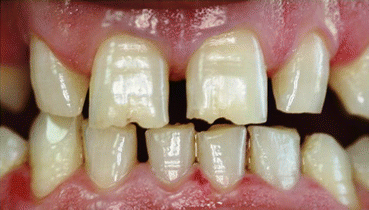Fig. 1.1
A 20-year-old patient representing approximately 0.5 mm midline diastema without any esthetic complaint
The etiology of diastema, may be a disproportion in size and shape of the teeth, affecting the dental harmony [3] (Fig. 1.2). Consequently, these problems can cause the formation of single or polydiastema in the arch. Therefore, a comprehensive examination and detailed diagnosis are importantfor understanding the contributing factors of diastema in adult dentition before planning the appropriate treatment [1, 4].


Fig. 1.2
The patient representing disproportionate teeth with polydiastema
Current literature suggests that diastemas can be treated by orthodontics, restorative dentistry and prosthodontics or by their combinations [5–8]. In some of the cases, periodontal surgery either frenectomy or crown lengthening or in both (Fig. 1.3a, b) would also be necessary in diastema closure for creating a long-term harmony between the final restoration and soft tissue morphology [5, 6]. Therefore, a careful diagnosis, meticulously prepared treatment plan addressing the causative factors of diastema and communication with the patient would allow the practitioner to select the best treatment option for each case [1].


Fig. 1.3
(a) A midline diastema due to enlarged frenum and relatively short tooth crowns. (b) Surgical frenectomy and gingival crown lengthening procedure at the same visit
Among the suggested treatment options, orthodontic treatment stands for effectively correcting the diastema beside the high appreciation of the patients despite the longer treatment time and expensive treatment costs [1, 6]. However, this treatment option is not able to correct all diastema cases with a satisfactory results, especially in the presence of excessive spaces [1, 6]. For this reason, restorative treatment with or without periodontal surgery is also mandatory for optimal treatment outcome. On the other hand, restorative treatments either by direct application with resin composite restorations or indirectly with porcelain laminate veneers (PLVs) are minimal invasive diastema closure procedures that have been described as successful restorative treatments [1, 4, 9–11].
Soft tissue considerations are also essential for creating a harmonious and esthetic final result between the restorations, hard tissues and surrounding gingiva [8
Stay updated, free dental videos. Join our Telegram channel

VIDEdental - Online dental courses


